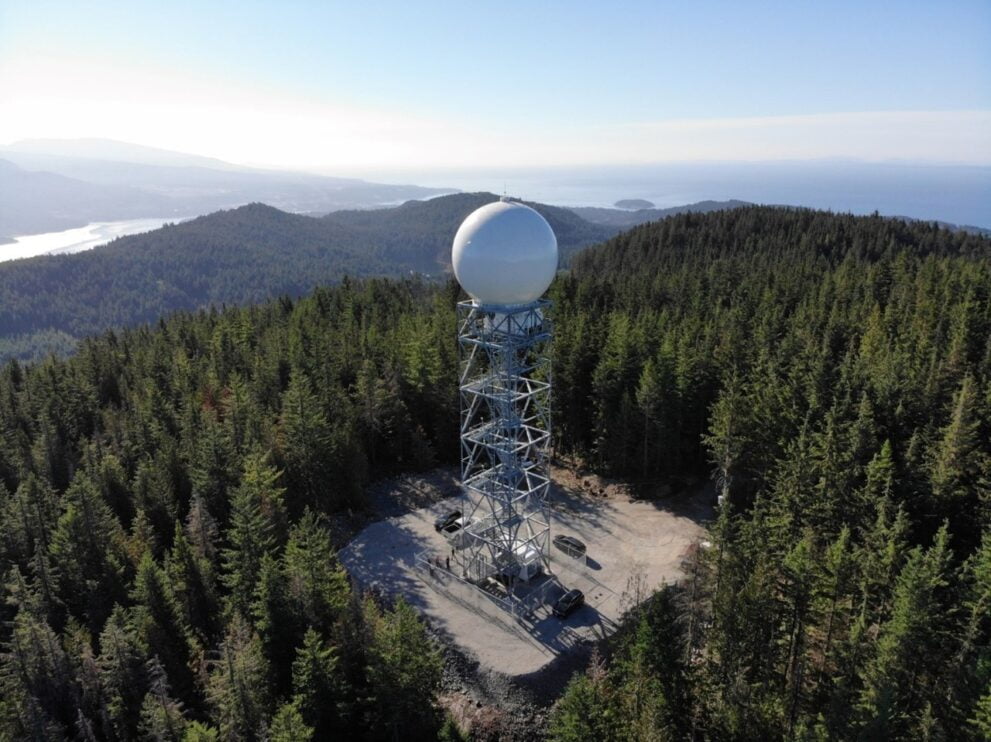Ottawa – Environment and Climate Change Canada has fully replaced its operational weather-radar network with new, state-of-the-art radars across the country. This fully modern, sustainable network will improve the department’s ability to track and detect severe weather.
Using the new radars, forecasters are better able to distinguish between rain, snow, hail, and freezing rain over an extended range covering more of Canada. Replacing the aging network with new, modern weather radars will help keep Canadians better informed about changing weather and provide more lead time to take appropriate actions to protect themselves, their family, and property from the effects of severe weather.
About the new radars
The new radars in Canada’s network provide:
- Canadians and weather-dependent industries with access to more accurate and timely weather information. This will help people make more informed decisions that are critical to the safety and cost-effectiveness of business operations. Examples include:
- Increased lead time for provinces and municipalities to prepare for storms, floods, or any severe weather events by ensuring emergency crews are available and well positioned to intervene rapidly and minimize the impact on the population.
- Improved air traffic safety, as weather forecasts are used to help route planes around severe weather. More accurate weather forecasts will also have a direct impact on daily airline operation costs as they can better determine plane trajectories, the number of planes in corridors, and the required space between them. The new radars are particularly effective at picking up areas of wind shear or severe turbulence at a longer range than before.
- Spotting damaging hail with enough lead time for people to protect their property.
- Safer marine activities and more precise weather information to support search and rescue missions.
- Higher data quality, better ability to detect beyond nearby storms, and better overall severe summer and winter weather detection, which will help improve the overall performance of weather warnings.
- An extended range to cover more of Canada, increasing the geographic area that forecasters can monitor for severe weather.
- The Doppler coverage area/detection range of the new radars increased from just over one million square kilometres to over four million square kilometers, including almost all of the more populated and thunderstorm-prone areas of southern Canada.
- The conventional radar range of the new radars has been extended from 250 kilometres to 330 kilometres with more than 99 percent of Canadians living within 330 kilometres of a Canadian radar. This gives Canadians greater lead time to protect themselves and their families from tornadoes and other severe weather. Extending Doppler coverage of the weather-radar network also allows for better overlap of neighbouring radars in case of an outage.
- More frequent data updates every six minutes, rather than 10 minutes. This means that data gets to the meteorologists more quickly for interpretation and forecasting.
- Pulses emitted in two directions: horizontal and vertical. This allows meteorologists to identify shapes to distinguish between heavy rain, hail, and snow, as well as enabling better identification of non-meteorological targets such as birds, bugs, and even tornado debris. This helps meteorologists better detect and predict severe weather events, such as tornadoes, at an extended range.
- Increased ability to see into and through dense weather systems, so forecasters can view severe weather developing behind large storm cells.
- Less radar downtime, thanks to reduced maintenance requirements and simpler repairs. Radar locations:
- Halfmoon Peak (Sunshine Coast)
- Aldergrove (near Vancouver)
- Prince George
- Silver Star Mountain (near Vernon)
- Bethune (near Regina)
- Carvel (near Edmonton)
- Foxwarren (near Brandon)
- Cold Lake
- Radisson (near Saskatoon)
- Schuler (near Medicine Hat)
- Spirit River (near Grande Prairie)
- Fort McMurray
- Strathmore (near Calgary)
- Woodlands (near Winnipeg)
- Britt (near Sudbury)
- Dryden
- Exeter (near London)
- Franktown (near Ottawa)
- King City (near Toronto)
- Montreal River (near Sault Ste. Marie)
- Smooth Rock Falls (near Timmins)
- Shuniah (near Thunder Bay)
- Mont Apica (near Saguenay)
- Landrienne (near Rouyn-Noranda)
- Blainville (near Montréal)
- Val-d’Irène (near Mont-Joli)
- Sainte-Françoise (near Trois-Rivières)
- Chipman (near Fredericton)
- Gore (near Halifax)
- Marion Bridge (near Sydney)
- Holyrood (near St. John’s)
- Marble Mountain (near Corner Brook)








